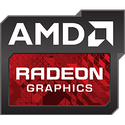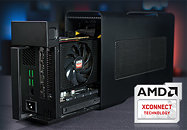Thursday, March 10th 2016

AMD Announces the XConnect External Graphics Technology with Razer and Intel
AMD today announced AMD XConnect technology, making it easier than ever to pair a powerful external Radeon graphics card with a compatible notebook or 2-in-1 using Thunderbolt 3. AMD XConnect technology is a groundbreaking new feature of Radeon Software Crimson Edition 16.3. Traditionally, PC gamers have been faced with the problem of choosing between gaming notebooks, sacrificing portability for gaming performance, or ultrathin notebooks, sacrificing gaming performance for portability.
A lightweight notebook or 2-in-1 with Thunderbolt 3 that is compatible with AMD XConnect technology brings the best of both worlds to life -- conveniently lightweight on its own, but as needed, can easily tap into serious framerates and image quality of a gaming notebook with a powerful external GPU. The connection between the external GPU enclosure configured with Radeon R9 300 Series graphics is made possible over Intel's Thunderbolt 3, and can be connected or disconnected at any time, a first for external GPUs."AMD XConnect technology is representative of the Radeon Technologies Group's on-going commitment to gamers. With the introduction of our user-friendly plug-and-play external GPU solution, gamers no longer need to sacrifice portability for powerful performance in notebook gaming," said Raja Koduri, Senior Vice President and Chief Architect, Radeon Technologies Group, AMD. "As innovators paving the way with an ingenious external GPU solution for notebooks, we look forward to creating a thriving ecosystem of notebooks enabled with AMD XConnect technology in collaboration with leading manufacturers."
AMD is also pleased to reveal that there is a notebook available today that can unlock the potential of AMD XConnect technology, brought to you in a collaboration with Intel's Thunderbolt group and Razer: The Razer Blade Stealth, a brand new ultrathin notebook compatible with AMD XConnect technology, and the Razer Core, an external GPU enclosure that connects to the Razer Blade Stealth notebook via Thunderbolt 3. When the Razer Core is equipped with a Radeon R9 300 Series GPU, gamers can experience desktop-like gaming performance in a convenient plug-and-play solution on a Stealth running an AMD XConnect compatible driver. Configuring the Razer Core with a Radeon R9 300 Series GPUs even allows gamers to play on the Blade Stealth's high-resolution IGZO screen, or connect to an external AMD FreeSync-enabled monitor for a breathtakingly smooth gaming experience.
"The Razer Blade Stealth was developed as the ultimate Ultrabook for work on-the-go, additionally capable of transforming into a desktop gaming environment when connected to Razer Core, thanks in part to remarkable contributions from AMD and Intel," says Min-Liang Tan, Razer CEO and cofounder. "The collaboration and development between Razer and AMD for users with Radeon R9 300 Series graphics in the Razer Core helped us realize the world's first Thunderbolt 3 plug-and-play external graphics solution. A single Thunderbolt 3 connection now provides power and data between the Blade Stealth and Core, and other peripherals can connect to the Razer Core's USB ports to provide a desktop-class gaming experience."
"Thunderbolt 3 brings Thunderbolt to USB-C at speeds up to 40Gb/s, creating one compact port that does it all," said Jason Ziller, Director of Thunderbolt Marketing, Intel. "Thanks to technical collaboration with the Radeon Technologies group at AMD, desktop Radeon graphics cards are now validated for use with Thunderbolt 3. AMD's new XConnect technology brings effortless plug-and-play support and a convenient management interface to notebooks and 2-in-1s with the Thunderbolt 3 external graphics solution configured with a powerful Radeon R9 300 Series GPU."
AMD plans to expand the list of Radeon GPUs that can support AMD XConnect technology, which will enable gamers to upgrade their enclosures beyond the Radeon R9 300 Series.
For a list of compatible GPUs, visit this page.
A lightweight notebook or 2-in-1 with Thunderbolt 3 that is compatible with AMD XConnect technology brings the best of both worlds to life -- conveniently lightweight on its own, but as needed, can easily tap into serious framerates and image quality of a gaming notebook with a powerful external GPU. The connection between the external GPU enclosure configured with Radeon R9 300 Series graphics is made possible over Intel's Thunderbolt 3, and can be connected or disconnected at any time, a first for external GPUs."AMD XConnect technology is representative of the Radeon Technologies Group's on-going commitment to gamers. With the introduction of our user-friendly plug-and-play external GPU solution, gamers no longer need to sacrifice portability for powerful performance in notebook gaming," said Raja Koduri, Senior Vice President and Chief Architect, Radeon Technologies Group, AMD. "As innovators paving the way with an ingenious external GPU solution for notebooks, we look forward to creating a thriving ecosystem of notebooks enabled with AMD XConnect technology in collaboration with leading manufacturers."
AMD is also pleased to reveal that there is a notebook available today that can unlock the potential of AMD XConnect technology, brought to you in a collaboration with Intel's Thunderbolt group and Razer: The Razer Blade Stealth, a brand new ultrathin notebook compatible with AMD XConnect technology, and the Razer Core, an external GPU enclosure that connects to the Razer Blade Stealth notebook via Thunderbolt 3. When the Razer Core is equipped with a Radeon R9 300 Series GPU, gamers can experience desktop-like gaming performance in a convenient plug-and-play solution on a Stealth running an AMD XConnect compatible driver. Configuring the Razer Core with a Radeon R9 300 Series GPUs even allows gamers to play on the Blade Stealth's high-resolution IGZO screen, or connect to an external AMD FreeSync-enabled monitor for a breathtakingly smooth gaming experience.
"The Razer Blade Stealth was developed as the ultimate Ultrabook for work on-the-go, additionally capable of transforming into a desktop gaming environment when connected to Razer Core, thanks in part to remarkable contributions from AMD and Intel," says Min-Liang Tan, Razer CEO and cofounder. "The collaboration and development between Razer and AMD for users with Radeon R9 300 Series graphics in the Razer Core helped us realize the world's first Thunderbolt 3 plug-and-play external graphics solution. A single Thunderbolt 3 connection now provides power and data between the Blade Stealth and Core, and other peripherals can connect to the Razer Core's USB ports to provide a desktop-class gaming experience."
"Thunderbolt 3 brings Thunderbolt to USB-C at speeds up to 40Gb/s, creating one compact port that does it all," said Jason Ziller, Director of Thunderbolt Marketing, Intel. "Thanks to technical collaboration with the Radeon Technologies group at AMD, desktop Radeon graphics cards are now validated for use with Thunderbolt 3. AMD's new XConnect technology brings effortless plug-and-play support and a convenient management interface to notebooks and 2-in-1s with the Thunderbolt 3 external graphics solution configured with a powerful Radeon R9 300 Series GPU."
AMD plans to expand the list of Radeon GPUs that can support AMD XConnect technology, which will enable gamers to upgrade their enclosures beyond the Radeon R9 300 Series.
For a list of compatible GPUs, visit this page.

38 Comments on AMD Announces the XConnect External Graphics Technology with Razer and Intel
Thunderbolt for the serious gaming laptops, or at least serious CPU power laptops with IGP - and the dedicated external GPU.
Would beIt's greatifit reallywasis 40Gb/sbut it's not because it actually is 40Gbit/sso 5GB/s which is the same as PCI-E 2.0 x10 or PCI-E 3.0 x5.A solution like this would be a compromise between a desktop and a laptop, both from performance and space perspective.
Issue is most people already have too many devices lying around the house, and the desktop it is supposed to replace can have multiple roles: NAS, Media Server and a Gaming PC. With this solution you need a box for NAS, another one for graphics ... its more messy.
Though, it would also go very well with a "bring your own device program" from the company where you work, or if everybody in the house already has laptops as any laptop can benefit from increased GPU power when needed.
What I didn't see is the price though.
Look at all those "2-in-1" laptops with keyboard docks.
The keyboard dock can literally add a fan cooled performance GPU and an extended battery.
With laptops yeah it will for sure be better than built in. Maybe even viable for desktops that want multiGPU but don't have the room or board for it. Consider 40GBps...what's SLI bridge do? Maybe 1GB? I know nVidia really hasn't done much with the technology since they bought it from 3Dfx. Why AMD has been scoring wins with Crossfire because it goes right through the sockets and boards now with all the bandwith it needs.
The Razor web page also says it's plug and play for both AMD and Nvidia, further, Extreme tech web site said Nvidia quietly rolled out a driver for plug and play during CES.
Nvidia would have more to lose with its mobile Maxwell in quite a few laptops, so I guess that's why they're staying quiet while supporting it.
FTR, only Razor have a laptop BIOS to support the feature for now, apparently.
/googles for cheapest notebook with TB3 port
a) shared bandwidth
b) substantial overhead/latency
Thunderbolt is to USB as NVMe is to SATA. Yeah, yeah, it could be done but should it be done especially when it is meant to be paired to a $300+ USD graphics card? I'd argue not. That said, 5 GB/s for Thunderbolt 3 is disappointing.
As the above pointed out, Thunderbolt isn't the runaway success Intel was hoping it to be. I think this will be most appealing to workstation laptop bulk purchasers (e.g. designing/drafting businesses). This allows them to have modest graphics and good battery life in the field with serious graphics at the office where productivity is paramount. This could be huge for AMD but no doubt NVIDIA will be close behind.
It looks like GCN 1.1 cards and newer are supported.
Thunderbolt was born as an optical technology but copper was adopted because of costs.
www.techpowerup.com/reviews/AMD/R9_Fury_X_PCI-Express_Scaling/1.html
techreport.com/news/29649/nvidia-361-75-drivers-support-thunderbolt-3-external-graphics
Suddenly, console upgrades are possible (we know they'd lock it down to their specific hardware options, but still the mere idea)
Personally I agree with this, that it would not be a very good idea.